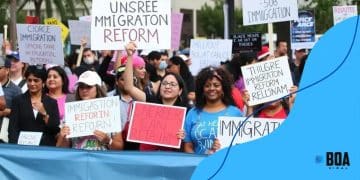Federal immigration reform: what you need to know

Supporting federal immigration reform involves educating yourself, advocating for change, volunteering with organizations, and participating in community events to promote inclusivity and raise awareness about the benefits of fair immigration policies.
Federal immigration reform is a hot topic, especially as policies continue to evolve. Have you ever wondered how changes may affect your community and future opportunities? Let’s dive into what’s at stake.
Understanding the current immigration landscape
The landscape of immigration in the United States has changed significantly over the years. Many factors influence these changes, including government policies, economic conditions, and social attitudes. Understanding this current immigration landscape is crucial as it affects millions of people.
Key Factors Shaping Immigration Today
Several key factors are influencing immigration policies and practices. Here are some of the main reasons:
- Economic Opportunities: Many individuals migrate in search of better job prospects.
- Family Reunification: Families often seek to reunite with loved ones who have already settled in the U.S.
- Political Instability: People fleeing violence or persecution in their home countries contribute to immigration rates.
- Legal Pathways: Changes in visa regulations and asylum policies can impact immigration trends.
These factors create a complex web of challenges and opportunities. For instance, with the rise of job opportunities in certain sectors, many migrants find a foothold in the workforce, contributing to local economies. In contrast, political discussions surrounding immigration reform can lead to uncertainty and fear for those seeking a better life.
Furthermore, public opinion plays a vital role in shaping the current immigration landscape. Sometimes, sentiments are divided, leading to heated discussions in communities across the country. Understanding these varying viewpoints helps us see the bigger picture.
Current Policy Trends
Another critical aspect is how policies are adapting to these changes. Recently, there have been shifts toward more inclusive practices, attempting to balance security concerns with humanitarian needs. For instance, new proposals often include:
- Pathways to Citizenship: Offering undocumented immigrants a chance to legalize their status.
- Refugee and Asylum Seeker Support: Enhancing protections for those fleeing dangerous situations.
- Work Visas: Expanding opportunities for skilled labor from abroad.
By following these trends, individuals can better understand their place and potential within the U.S. immigration system. As the landscape continues to evolve, staying informed is key.
Key proposals in the federal immigration reform
Understanding the key proposals in the federal immigration reform is essential for recognizing how changes will impact individuals and families. As lawmakers discuss these proposals, the intentions are to create a fair and just system that can support diverse needs. Here are some of the primary proposals being considered.
Pathways to Citizenship
One significant proposal includes creating pathways to citizenship for undocumented immigrants. This change aims to provide a legal status to individuals who have been living in the country for an extended time. The benefits include:
- Enhanced social integration for families.
- Access to better employment opportunities.
- The ability to contribute to local economies.
These pathways are designed to help those who have demonstrated commitment and stability in their communities.
Reform of Visa Programs
Another critical aspect is the reform of existing visa programs. Many people come to work, study, or join family members in the U.S. Changes to these programs could include:
- Increased availability of work visas in high-demand sectors.
- Streamlined processes for processing applications.
- Focus on allowing skilled labor to fill gaps in the workforce.
Such reforms could significantly benefit the economy by meeting labor shortages while also bringing talent to various industries.
Moreover, the proposals often emphasize improving the asylum-seeking process, making it more efficient and humane. This change aims to address humanitarian concerns while ensuring national security. Enhancing the asylum process would allow individuals fleeing danger to find safety more effectively.
Focus on Enforcement and Security Measures
While reforming pathways and visas, a strong focus on enforcement and security also exists. Proposed measures include:
- Increased funding for border security technologies.
- Collaboration with local law enforcement to address illegal activities.
- Ensuring that immigration laws are enforced fairly.
Such measures aim to balance the need for security while welcoming those who contribute positively to society. Understanding these proposals will shed light on how the federal immigration reform could evolve and its potential impact on communities across the nation.
Impact of immigration reform on communities

The impact of immigration reform on communities can be profound and multifaceted. As policies change, they can directly affect the lives of individuals and families, often reshaping the cultural and economic landscapes of neighborhoods.
Economic Contributions
One major impact is on local economies. Immigrants often fill essential jobs, contributing to various industries such as agriculture, healthcare, and technology. This presence can lead to:
- Increased labor supply, benefiting businesses.
- Higher overall economic growth due to spending and investment.
- Creation of new businesses and services.
These factors help stimulate the economy and can create a more vibrant community.
Cultural Diversity
Immigration reform encourages cultural diversity within communities. As new residents bring different traditions, languages, and perspectives, communities become richer and more dynamic. This diversity can lead to:
- Increased cultural events and celebrations.
- Enhanced creativity and innovation.
- Broader educational opportunities for everyone.
As communities celebrate these differences, they often become more united and cohesive.
However, changes in immigration policies can also lead to challenges. Some community members may feel uncertain about the influx of newcomers, leading to tension or misunderstandings. Addressing these concerns requires open communication and education about the benefits of having diverse populations.
Communities may also experience adjustments in public services and resources. As the population grows, there may be increased demand for schools, healthcare, and public safety. Planning for these changes is crucial to ensure that all residents can thrive.
Political and Social Dynamics
The political landscape can shift significantly in response to immigration reform. Local leaders may need to adapt their strategies to address the needs of both longtime residents and newer arrivals. This situation can create opportunities for:
- Greater community engagement and participation.
- Increased support for local initiatives that foster understanding.
- Collaboration among diverse groups to solve common problems.
By working together, communities can create environments where everyone feels valued, safe, and supported. The implications of immigration reform are vast, affecting not only the economy but also the social fabric of communities.
Challenges lawmakers face in passing reforms
Lawmakers face several challenges when attempting to pass immigration reforms. These obstacles often stem from divisive political climates, differing public opinions, and complex legal frameworks. Understanding these challenges can provide insight into the slow evolution of immigration policy.
Political Division
The political landscape in the U.S. is highly polarized. Lawmakers are often split along party lines when it comes to immigration. This division makes it difficult to reach a consensus on proposed reforms. For example, many Republicans may emphasize border security, while Democrats often focus on pathways to citizenship. These differing priorities can hinder lawmaking efforts.
Public Opinion
Public opinion plays a crucial role in shaping immigration policy. Some communities welcome immigration, seeing it as a source of strength and diversity. Others may harbor concerns about resource allocation and job competition. This mixed sentiment can pressure lawmakers to adjust their proposals, complicating the reform process. Addressing these concerns requires delicate communication and outreach.
Complex Legal Frameworks
Immigration laws are intricate and often outdated. Navigating these laws while drafting new reforms is a considerable challenge. Lawmakers must ensure that proposals comply with existing regulations and consider their long-term implications. In many cases, reforms might require comprehensive changes to various legal statutes, making the process even more complicated.
Another important aspect is the role of special interest groups. Advocacy organizations, business leaders, and grassroots campaigns all influence the discussion surrounding immigration. These groups can be both supportive and opposing forces, further complicating the legislative process. Their involvement can lead to additional negotiations and adjustments, making timely passage of reforms more difficult.
Additionally, the emotional aspect of immigration cannot be overlooked. Stories of families being separated, individuals facing deportation, or those seeking asylum add urgency to the reforms. Lawmakers should consider these narratives when formulating proposals. The challenge lies in balancing these human experiences with legal and practical considerations.
Ultimately, the path to passing immigration reforms is fraught with challenges. However, understanding these obstacles can help all involved, from lawmakers to citizens, work together towards effective solutions.
What you can do to support immigration reform
Supporting immigration reform is critical for fostering a fair and just system. Individuals can take various actions to actively contribute to the cause. Understanding how to make a difference can empower communities and influence positive change.
Educate Yourself and Others
One of the first steps is to educate yourself about immigration issues. Understanding the current laws, proposals, and the real experiences of immigrants is essential. Knowledge helps you engage in conversations about reform effectively.
Engage with Local Organizations
Numerous organizations work tirelessly to support immigrants and push for reform. You can help by volunteering your time or making donations. These groups often depend on community support to continue their work. Here are some ways to get involved:
- Join local advocacy groups.
- Participate in community events focused on immigration.
- Assist in organizing fundraising activities.
Building connections with organizations can amplify your impact.
Advocate for Change
Advocacy is a powerful tool in supporting immigration reform. You can reach out to your elected officials to express your views on immigration policies. This can include:
- Writing letters or emails to your representatives.
- Attending town hall meetings to voice your concerns.
- Using social media to raise awareness about immigration issues.
Your voice matters, and lawmakers often pay attention to the concerns of their constituents.
Additionally, sharing stories of immigrants’ contributions to society humanizes the issue. Personal narratives can resonate deeply and encourage others to support reform. Partnering with those who have lived experiences can help break down stereotypes and foster understanding.
Participate in Local Events
Joining local events focused on immigration can show support and encourage dialogue. Community forums, workshops, and marches allow individuals to gather and advocate for change together. Participation in these events can create a strong community presence in support of reform.
Finally, consider promoting inclusivity in your daily life. Whether it’s learning about different cultures or simply fostering kindness toward immigrants in your community, small actions can contribute to a larger movement. Taking these steps can help pave the way for effective immigration reform and create a more welcoming environment for all.
FAQ – Frequently Asked Questions about Immigration Reform
How can I support immigration reform in my community?
You can support immigration reform by educating yourself about the issues, volunteering with local organizations, and advocating for change with your elected officials.
What are the main benefits of immigration reform?
Benefits include economic growth, cultural diversity, and creating a more inclusive society that values the contributions of all its members.
Why is public opinion important for immigration reform?
Public opinion influences lawmakers and can drive policy changes, making it essential for everyone to engage in conversations about immigration.
How do grassroots movements affect immigration policy?
Grassroots movements raise awareness, mobilize communities, and put pressure on lawmakers to adopt fair and humane immigration policies.






